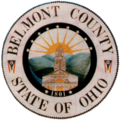2010 census
As of the 2010 United States census, there were 70,400 people, 28,679 households, and 18,761 families in the county. [30] The population density was 132.3 people per square mile (51.1 people/km2). There were 32,452 housing units at an average density of 61.0 units per square mile (23.6/km2). [31] The racial makeup of the county was 94.0% white, 4.0% black or African American, 0.4% Asian, 0.1% American Indian, 0.2% from other races, and 1.3% from two or more races. Those of Hispanic or Latino origin made up 0.6% of the population. [30] In terms of ancestry, 26.0% were German, 17.9% were Irish, 12.4% were English, 10.1% were Italian, 9.0% were Polish, and 6.2% were American. [32]
Of the 28,679 households, 27.2% had children under the age of 18 living with them, 49.2% were married couples living together, 11.4% had a female householder with no husband present, 34.6% were non-families, and 29.9% of all households were made up of individuals. The average household size was 2.32 and the average family size was 2.85. The median age was 43.4 years. [30]
The median income for a household in the county was $38,320 and the median income for a family was $47,214. Males had a median income of $42,022 versus $26,926 for females. The per capita income for the county was $20,266. About 12.1% of families and 15.2% of the population were below the poverty line, including 24.4% of those under age 18 and 9.1% of those age 65 or over. [33]
2000 census
As of the 2000 United States census, [34] there were 70,226 people, 28,309 households, and 19,250 families in the county. The population density was 132.0 per square mile (51.0/km2). There were 31,236 housing units at an average density of 58.7 units per square mile (22.7/km2). The racial makeup of the county was 94.98% White, 3.64% Black or African American, 0.14% Native American, 0.30% Asian, 0.02% Pacific Islander, 0.16% from other races, and 0.77% from two or more races. 0.39% of the population were Hispanic or Latino of any race. 20.2% were of German, 12.5% Irish, 12.0% American, 10.3% English, 10.2% Italian and 9.0% Polish ancestry according to the 2000 census.
There were 28,309 households, out of which 28.30% had children under the age of 18 living with them, 53.10% were married couples living together, 11.20% had a female householder with no husband present, and 32.00% were non-families. 28.70% of all households were made up of individuals, and 15.10% had someone living alone who was 65 years of age or older. The average household size was 2.37 and the average family size was 2.90.
The county population contained 21.80% under the age of 18, 7.70% from 18 to 24, 27.40% from 25 to 44, 24.90% from 45 to 64, and 18.20% who were 65 years of age or older. The median age was 41 years. For every 100 females there were 96.40 males. For every 100 females age 18 and over, there were 93.60 males.
The median income for a household in the county was $29,714, and the median income for a family was $37,538. Males had a median income of $31,211 versus $19,890 for females. The per capita income for the county was $16,221. About 11.70% of families and 14.60% of the population were below the poverty line, including 20.40% of those under age 18 and 9.80% of those age 65 or over.






